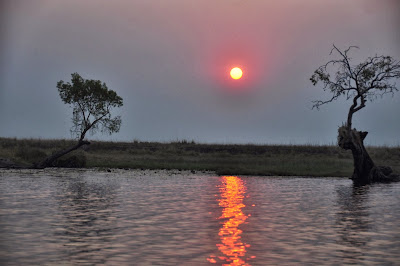Life on the Zambezi Queen was pretty wonderful. Out in the morning for a river safari (calm river, comfortable boat, no bumps, nice breeze), back for lunch, rest up a little, out in the evening for another activity, back to rest up a little in order to have cocktails, conversation and the general conviviality that can build amongst one time strangers, now friends with shared experiences. As I said in the beginning, we could not have been traveling with better people and that prescient comment only proved more correct as our time together grew.
Our first afternoon safari took us to a village on the shore of the Zambezi. Not exactly on the shore, but far enough away from the river that crocodiles usually didn't come up that far. Not that marauding elephants, hungry hippos or occasional big cats didn't come through, but behind what looked like rather flimsy barriers lived about thirty people. They earned money by fishing in the Chobe and actually sold fish as far away as Angola. There were no roads to the village. The only ways in or out where by water or by foot.
While the Maasai had mud walls covered with thorns surrounding their villages, this one had bamboo poles stuck in the ground. The back of the village was completely open. There was no electricity and the nearest clean water was about a quarter mile away. They did raise chickens, and had some grains as well as fish, but we didn't see a cow in sight. There was a communal oven, but each house had one pot over a wood fire to cook in. Sand was the flooring. Loose outside the huts, hard packed
within.
A typical house in the village. They are built by pounding stakes in the ground and then filling in-between them with mud and finally plastering over the dried mud with dung. The roofs are all thatched. Most had only one room for the family, a very few had two. The latrines were on the borders of the village. Sponge baths were taken by heating water in the one pot and bathing. The Chief felt that they were living very well and with the Zambezi Queen bringing tourists they were relieved somewhat from relying on fishing which was very difficult during the rainy season.
As with everywhere we met the people we were warmly greeted. The children always stole one's heart. One hears that African hospitality is unparalleled and from our brief encounters we could sense the warmth of the people as well as curiousity they had about these white skins folks, especially in the villages. We only wish we could have had more interaction with them.
In this village everyone turned out to welcome us with a song.
Our first afternoon safari took us to a village on the shore of the Zambezi. Not exactly on the shore, but far enough away from the river that crocodiles usually didn't come up that far. Not that marauding elephants, hungry hippos or occasional big cats didn't come through, but behind what looked like rather flimsy barriers lived about thirty people. They earned money by fishing in the Chobe and actually sold fish as far away as Angola. There were no roads to the village. The only ways in or out where by water or by foot.
While the Maasai had mud walls covered with thorns surrounding their villages, this one had bamboo poles stuck in the ground. The back of the village was completely open. There was no electricity and the nearest clean water was about a quarter mile away. They did raise chickens, and had some grains as well as fish, but we didn't see a cow in sight. There was a communal oven, but each house had one pot over a wood fire to cook in. Sand was the flooring. Loose outside the huts, hard packed
within.
A typical house in the village. They are built by pounding stakes in the ground and then filling in-between them with mud and finally plastering over the dried mud with dung. The roofs are all thatched. Most had only one room for the family, a very few had two. The latrines were on the borders of the village. Sponge baths were taken by heating water in the one pot and bathing. The Chief felt that they were living very well and with the Zambezi Queen bringing tourists they were relieved somewhat from relying on fishing which was very difficult during the rainy season.
In this village everyone turned out to welcome us with a song.
Of course the faces of the children were captivating.
We left the village as the sun was setting and the ride back was rather quiet for this group as people were no doubt thinking of what it would be like to be in that village as night fell and solitary scenes presented themselves on the ride back to the boat.












No comments:
Post a Comment